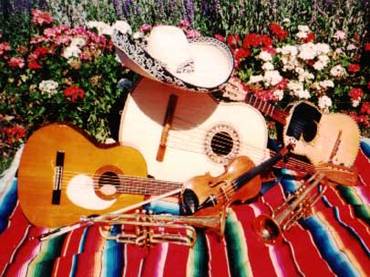Sinfonía à la Mariachi (1998)
Duration: 24 minutes
3(pic)3(ca)3(Ebcl)3(cbn)/4431/timp.3perc/acn.gtr.hp.pf(hpd)
/str/mariachi band ad lib
Commissioned by The San Antonio Symphony
Premiere Performance: March 19, 1998; San Antonio Symphony;
Christopher Wilkins, Conductor

I. Mariage
II. Calaveras
III. Las Barricadas Mysteriosas
IV. Plaza de los Mariachis
(movements may be performed separately)
Review:
...For much of this century, partisans of classical and popular music have been encamped on opposites sides of a chasm... Robert X. Rodríguez sees that the chasm is imaginary. In his Sinfonía à la Mariachi... scored for a large orchestra divided into two ensembles... the two sides swap family tales from the two ends of a love seat...
The orchestra on the left plays a synthesis of European classical styles, sometimes quoting old-master composers, in three of the movements. In the second this orchestra evokes both ancient Mayan flutes and drums and the chittering bird calls of Messiaen. The orchestra on the right is treated as a large mariachi band playing traditional tunes or new music in traditional styles.
When the two sides initially take turns speaking in widely dissimilar idioms, the listener may well wonder how on Earth they could be made to mesh coherently. And then Rodríguez pulls it all together with a Voila! and an Aha!... Particularly fetching were the second movement, whose mysterious atmospherics blended richly with traditional jarocho tunes; and the third, where echoes of Couperin and Pachelbel merge with a Spanish lullaby to create a whole of extreme loveliness...
Mike Greenberg, San Antonio Express-News
Program Note:
As the Spanish/French title indicates, Sinfonía à la Mariachi is a concert work inspired both by Mexican folk music and by the international roots of that music. Rodríguez has drawn upon pre-Columbian musical motifs as well as upon the timbres, textures and forms of the Mexican son jalisciense and the son jarocho. Traditional mariachi melodies are woven into the musical texture. In addition, there are classical Spanish and French musical references to suggest Mexico’s European cultural influences.
The first movement, Mariage, is a musical “marriage” of European classical style and indigenous Mexican folk styles. One orchestra plays Rodríguez’ orchestration of a harpsichord sonata by Mateo Albéniz (1760-1831), an 18th-Century Castilian chapel master. Over the graceful Albéniz, Rodríguez superimposes a second orchestra playing mariachi music, with trumpets and violins cascading flamboyant thirds over a highly syncopated rhythmic accompaniment in the style of the son jalisciense. The jarocho melody, El Cascabel, emerges as the classical European and mariachi styles join to create an intricate synthesis of their common elements.
The second movement, Calaveras, is a scherzo featuring the marimba in a depiction of the playfully sinister skeleton figures of Mexican folklore. Here the mariachi themes of the previous movement are recast in short, birdcall motifs suggesting the sounds of ancient Mayan flutes and drums. Classical European sounds are forgotten as exotic chromatic harmonies over an ostinato rhythmic incantation create a magical primeval atmosphere, out of which the mariachi ensemble reemerges playing two traditional jarocho tunes, El Ahualulco and El Camote.
The third movement, Las Barricadas Misteriosas (The Mysterious Barricades) is a serene adagio. Here the Spanish and Indian antecedents of mariachi join, accompanied by the additional element of the French, represented by Les Barricades Mystérieuses for harpsichord by François Couperin (1668-1733). Four programmatic elements thus revolve in a delicate musical mobile reminiscent of Charles Ives’ Unanswered Question: Couperin’s elegant rondeau (in the harp and high strings) is overlaid by strands of a tender Spanish lullaby (Señora Santana, in the oboe) decorated by reappearances of the mystical Indian birdcall motifs in flutes and percussion (as in the previous movement.). All, as usual, gives way to the mariachi, which is this time represented by four trumpets in answering pairs (a reference to the traditional mariachi practice of trumpets echoing long, melancholy phrases both before and behind the audience).
The festive finale, Plaza de los Mariachis, is a brilliant moto perpetuo built on the traditional four-bar chaconne variation form of the jarocho folk music of Veracruz. The music depicts the complex intertwining sounds of several different mariachi ensembles playing all at once in a public square, such as Mexico City’s Plaza Garibald. The texture intensifies in the work’s final pages as the two orchestras (joined by optional additional mariachis) simultaneously play all the major themes of the previous three movements (European, Indian and mariachi) in a triumphant quodlibet.